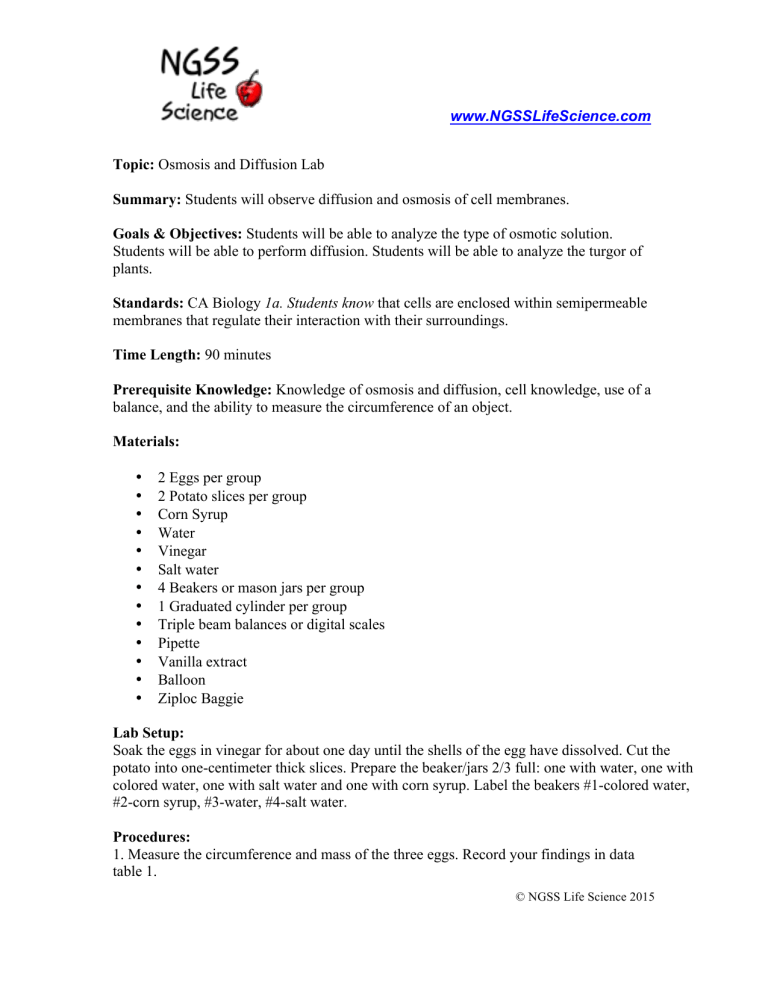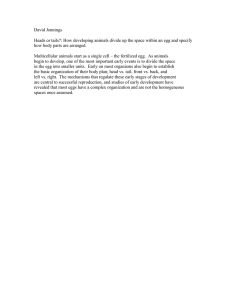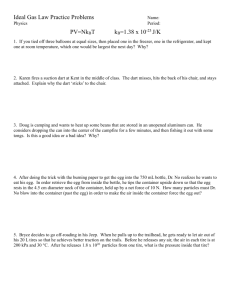
www.NGSSLifeScience.com Topic: Osmosis and Diffusion Lab Summary: Students will observe diffusion and osmosis of cell membranes. Goals & Objectives: Students will be able to analyze the type of osmotic solution. Students will be able to perform diffusion. Students will be able to analyze the turgor of plants. Standards: CA Biology 1a. Students know that cells are enclosed within semipermeable membranes that regulate their interaction with their surroundings. Time Length: 90 minutes Prerequisite Knowledge: Knowledge of osmosis and diffusion, cell knowledge, use of a balance, and the ability to measure the circumference of an object. Materials: • • • • • • • • • • • • • 2 Eggs per group 2 Potato slices per group Corn Syrup Water Vinegar Salt water 4 Beakers or mason jars per group 1 Graduated cylinder per group Triple beam balances or digital scales Pipette Vanilla extract Balloon Ziploc Baggie Lab Setup: Soak the eggs in vinegar for about one day until the shells of the egg have dissolved. Cut the potato into one-centimeter thick slices. Prepare the beaker/jars 2/3 full: one with water, one with colored water, one with salt water and one with corn syrup. Label the beakers #1-colored water, #2-corn syrup, #3-water, #4-salt water. Procedures: 1. Measure the circumference and mass of the three eggs. Record your findings in data table 1. © NGSS Life Science 2015 2. Place one egg into #1 beaker of water and the second egg in the #2 beaker with corn syrup. Wait for one hour to take a second measurement. 3. Feel the texture of the potato slices. Then put one slice into the fresh water, one slice into the salt water, and leave the third slice exposed to air. Wait for one hour to feel the difference. 4. Place 10 drops of Vanilla extract inside a deflated balloon. Make sure not to get any vanilla on the outside of the bag. Inflate the balloon to a size that will easily fit inside the bag. Place the balloon in the bag and seal up the bag. Wait for one hour. 5. Try to answer the questions in the analysis section until it has been one hour for the eggs in the beaker/jar. 5. Take the eggs out of their solutions and measure their circumference and mass. Place the eggs back into their solution. 6. Feel the texture of the two slices of potato. 7. Open the Ziploc bag and smell the air inside. Record your results in data table 3. 8. Let the bag sit open for 2 minutes. Smell the air inside once again. Record your results. Accommodations: Students with an IEP can take the handout home if they need extra time and/or do the even numbered questions, or just do the potato lab and not the other two. Evaluation: Each hypothesis is worth 2 points, for a total of 4 points. Each of the 12 questions is worth 3 points, for a total of 36 points. The conclusion is worth 5 points. This assignment is worth a total of 45 points. © NGSS Life Science 2015 Name: _______________________ Row: _______ Date:_____________ Period:______ Osmosis and Diffusion Lab Problem Statement: In this lab, you will observe the process of diffusion and osmosis. Three labs help demonstrate these processes. Each of these labs needs time to work. Hypothesis: If I put the egg in a hypotonic solution, then it will ______________________________. If I put the egg in a hypertonic solution, then it will ______________________________. Materials: • 2 Eggs per group • 3 Potato slices per group • Corn syrup • Water • Vinegar • Food coloring • Vanilla extract • 4 Beakers or mason jars • Balance or digital scale • 1 Graduated cylinder per group • Salt water • Pipette • Balloon • Ziploc bag Procedures: 1. Measure the circumference and mass of the two eggs. Record your data in the data table. 2. Place one egg into the #1 beaker of water and the second egg in the #2 beaker with corn syrup. Wait for one hour to take a second measurement. 3. Feel the texture of the potato slices. Put one slice into the fresh water, one slice into the salt water, and leave the third slice exposed to air. Wait for one hour to feel the difference. 4. Place 10 drops of Vanilla extract inside a deflated balloon. Make sure not to get any vanilla on the outside of the bag. Inflate the balloon to a size that will easily fit inside the bag. Place the balloon in the bag and seal up the bag. Wait for one hour. 5. Wait for one hour for osmosis/diffusion to occur. The teacher may have another assignment for you to do. 5. Take the eggs out of their solutions and measure the circumference and mass. Place the eggs back into their solution. 6. Feel the texture of the three slices of potato. 7. Open the Ziploc bag and smell the air inside. Record your results. © NGSS Life Science 2015 8. Let the bag sit open for 2 minutes. Smell the air inside once again. Record your results. Analysis: Use complete sentences when possible. Egg Lab Liquid Type Initial Mass Initial 1 Hour 1 Hour Circumference Mass Circumference 24 Hours Mass Hypertonic or Hypotonic 1) What is the independent variable for the egg lab? _____________________ 2) What are the dependent variables for the egg lab? ________________ ________________ 3) What happened to the water in the egg when placed into the colored water solution? _____________________________________________________________________________ 4) What happened to the water in the egg when placed into the corn syrup solution? _____________________________________________________________________________ 5) What type of solution was the corn syrup? _______________ colored water? _____________ Potato Lab 6) The texture of the fresh potato slice is turgid, in between or flaccid? ____________________ 7) What happened to the water in the potato when it was soaked in the water solution? _____________________________________________________________________________ 8) What happened to the water in the potato when it was soaked in saline solution? _____________________________________________________________________________ 9) Comparing the potato exposed to water and the potato soaked in saline solution. Which texture is more turgid? Why? ____________________________________________________ 10) Plant cells use the central vacuole to provide support for their cell walls. When a plant becomes turgid, what is happing inside the cell? ______________________________________ _____________________________________________________________________________ © NGSS Life Science 2015 11) What type of solution was the water solution? ___________ Saline solution? ____________ Vanilla Balloon Lab 12) After one hour, did it smell inside the bag? _______________________________________ 13) How did the smell get into the bag? _____________________________________________ 14) After the bag was open for two minutes, was the smell more or less concentrated compared to when you first opened it? Why? _________________________________________________ _____________________________________________________________________________ Conclusion: What is the difference between osmosis and diffusion? How does diffusion use concentration gradients? _____________________________________________________________________ ______________________________________________________________________________ ______________________________________________________________________________ © NGSS Life Science 2015



